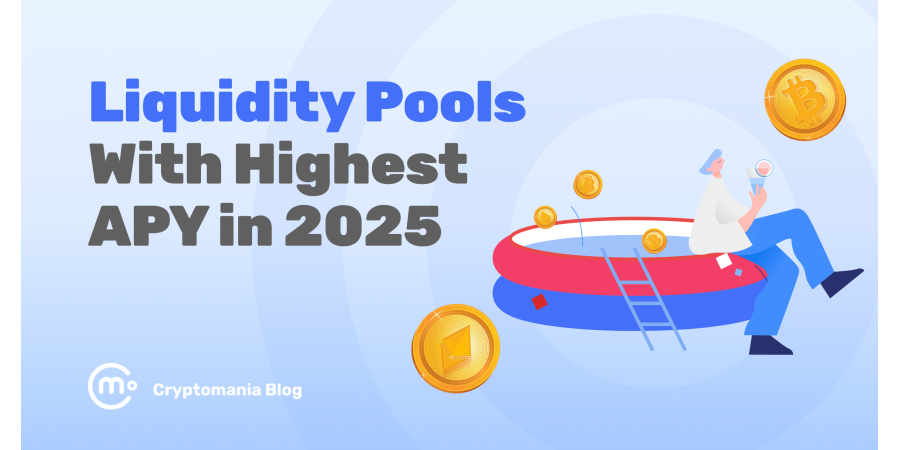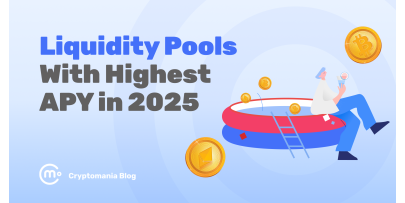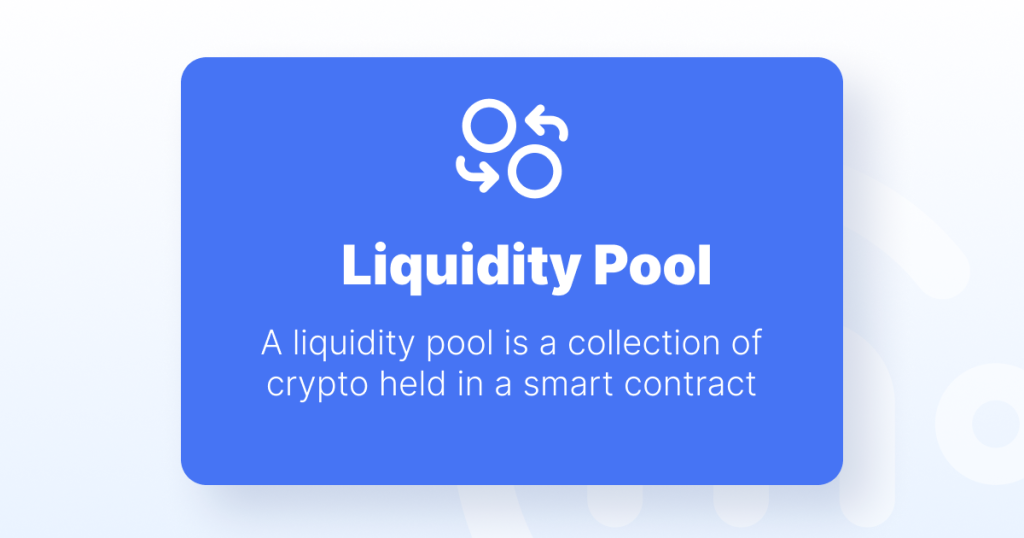6 Highest APY Liquidity Pools in 2025
Jane Savitskaya


Crypto liquidity pools are having another moment, and this time, it’s not just one-day hype.
In 2025, they’re driving some of the highest returns across DeFi, attracting both experienced traders and newbies looking for better yields than traditional staking or savings.
But before chasing those numbers, you need to understand how liquidity pools work and what makes some platforms stand out. High APY doesn’t always mean low risk, and not every pool deserves your tokens.
In this post, we’ll break down everything you need to know: from what liquidity pools are to how to invest in them safely, and of course, highlight the best crypto liquidity pools in 2025 with real APY stats.
Let’s start with the basics and see why DeFi liquidity pools are still the backbone of DeFi.
Liquidity pools explained
A liquidity pool is a shared pool of crypto that keeps decentralized exchanges running. Instead of matching buyers and sellers like traditional markets do, DeFi platforms use these pools to make trades happen instantly.

At the core of every liquidity pool is a smart contract — a piece of code that automatically manages deposits, swaps, and rewards. There’s no bank, broker, or human middleman involved. Everything runs on rules written into the blockchain.
Think of it as everyone putting their coins into one big basket so others can swap freely without waiting for a trading partner. Every trade pays a small fee, which is shared among the people who added their tokens to the pool.
Those people are called liquidity providers, and their role is simple: they supply assets and earn a share of the trading fees, sometimes along with extra rewards from the platform itself.
This system removes middlemen, speeds up transactions, and keeps decentralized exchanges liquid. It means traders can buy or sell at any time without waiting for someone on the other side.
How liquidity pools work
When you add funds to a pool, you’re pairing two tokens, like ETH and USDC. The pool always keeps a balance between them. If someone swaps ETH for USDC, the amount of ETH in the pool increases while the USDC decreases. The smart contract instantly adjusts the prices based on supply and demand, keeping things fair and automatic.
This system is called an automated market maker (AMM). It replaces the old-fashioned order book model used by centralized exchanges. Instead of waiting for someone to buy what you’re selling, you trade directly against the pool’s liquidity.
In return for providing your tokens, you earn a small cut of every trade that happens in that pool. The more trading volume, the more you earn. Some platforms also boost rewards by adding extra incentives, like governance tokens or farming bonuses.
Sounds great, right? You may ask what the catch is. Well, prices in the pool can shift compared to the open market, creating what’s called impermanent loss. We’ll get to that later, but for now, just know that liquidity pools make decentralized trading smooth, fast, and accessible for everyone without relying on big centralized players.
Best crypto liquidity pools in 2025
Here are six liquidity pools worth keeping on your radar in 2025. I picked ones with decent traction, plausible yields, and interesting mechanics. Use this as a shortlist, not a guarantee.
Uniswap V3 | WBTC / USDC
- Current APY: ~ 7.68% (7-day) / ~ 39.33% (30-day average) according to DefiLlama
- Why it’s interesting: High liquidity, solid trading volume, because WBTC and USDC are relatively stable assets compared to extreme tokens, the pool has a balance but still earns decent returns.
- Watch out for: Changes in BTC price movements, impermanent loss, how concentrated your liquidity range is.
Uniswap V3 | USDC / USDT
- Current APY: ~ 0.95% (for 30-day window)
- Why it’s interesting: The lowest volatility pair. Good for those who want yield with minimal risk.
- Watch out for: Incentives may vanish, and fees alone might not offset gas costs on Ethereum unless volume is high.
SushiSwap / Multi-chain pools
- APYs: Exact APYs vary by chain and program, but in strong reward periods, some pools reach double or even triple digit APYs (fees + rewards) depending on token demand.
-
Why it’s interesting:
-
You get trading fee earnings (0.25% fee on trades, of which 0.25% goes to liquidity providers)
-
Some pools also offer SUSHI token rewards, making yields more attractive.
-
Strong ecosystem, many chains, decent liquidity, and history.
-
- Watch out for: Reward dilution (if many enter), token price crashes, cross-chain risk.
PancakeSwap / BNB-chain pools
- APYs: Again, yields on PancakeSwap depend heavily on the token pair and reward token emissions.
- Why it’s interesting: Because gas is low, small gains per trade can stack.
- Watch out for: Chain risk (BNB chain), token risk, and reward schedules changing.
Uniswap / Protocol average
- APYs: Uniswap pools, aggregated, show an average APY around 49-50% (across many pools) in their tracked yields.
- Note: This average includes many wildly different pools (some stable, some volatile, some with heavy incentives).
- Watch out for: Use average as a benchmark, not a target: your specific pool will differ a lot.
Speculative / Incentive-heavy pools
Speculative (incentive-heavy pools) are pools created by newer projects or tokens — often small cap, with aggressive reward schemes to attract liquidity.
- APYs: These pools might offer APYs in the hundreds or even thousands of percent (temporarily).
Example: A project might launch a token and offer huge yield for early liquidity providers to bootstrap volume.
- Best for: For readers who are okay with risk and want outsized returns.
- Watch out for: This is the wild west. Many such pools fade or collapse. Token value can collapse faster than you earn yields. Rug pulls happen. Always check audits, tokenomics, project team, lockups, etc.
How to invest in liquidity pools safely
Jumping into liquidity pools can be rewarding, but only if you know what you’re doing. The good news: you don’t need to be a DeFi genius to start. You just need a plan, a clear head, and a healthy level of skepticism.
Here’s how to do it right:
1. Pick a reliable platform
Stick to established names like Uniswap, Curve, Balancer, SushiSwap, or PancakeSwap. These platforms have a track record, large user bases, and audited smart contracts. Smaller projects might offer jaw-dropping APYs, but there’s usually a reason why they need to do this, and it’s highly unlikely because they are super generous.
2. Choose token pairs you actually understand
Don’t just chase numbers. If you can’t explain what a token does, don’t park your funds in its pool.
- Stablecoin pairs (like USDC/USDT) are safer.
- Blue-chip pairs (like ETH/WBTC) balance risk and reward.
- Exotic or meme tokens? Enter at your own risk.
3. Check the real yield
High APY doesn’t always mean high profit. Some rewards are paid in volatile or inflationary tokens that can lose value fast. Look at:
- Trading fees (real, sustainable income)
- Reward tokens (bonus, but not guaranteed)
- Lockup terms (some pools restrict withdrawals)
If your “300% APY” is coming from a token that’s dropping 50% a week, it’s not really 300%.
4. Understand impermanent loss (and accept it)
When the price of one token in your pair moves a lot, you might end up with less value than if you just held both separately. That’s impermanent loss — it’s real, and it’s not a glitch.
Before adding liquidity, use a calculator (many DeFi dashboards have one) to estimate potential impact.
5. Start small and monitor often
You don’t need to go all in. Start with a small deposit, watch how it performs, and learn the mechanics.
- Track your LP position regularly.
- Withdraw or rebalance if the market shifts.
- Don’t ignore gas fees — they can eat into your yield.
6. Never skip security
- Double-check the official URL (phishing sites are everywhere).
- Verify smart contract addresses on trusted sources like DeFiLlama or CoinGecko.
- Don’t connect your main wallet to unknown dApps. Use a separate wallet for DeFi experiments.
7. Diversify and don’t fall in love with a pool
Even “safe” pools can go wrong. Spread your capital across different platforms and token pairs. DeFi rewards are great until a smart contract bug wipes out your earnings. Yup, it’s a possibility that never equals zero.
Quick checklist before you add liquidity
✅ Platform is reputable and audited
✅ Token pair makes sense
✅ APY is sustainable (not a gimmick)
✅ You understand the risk and reward
✅ You can afford to lose the amount you’re investing
Risks and кewards
Liquidity pools can either make your crypto work for you or drain it faster than a bear market. The outcome depends on what you choose and how you manage it.
And, please, remember: there’s no such thing as “risk-free yield” in DeFi. But the risk-to-reward ratio can still be worth it if you know what you’re getting into.
The upside
1. Passive income that actually scales
Trading fees keep flowing as long as there’s volume. Even small positions can generate steady income on active pairs.
2. No middlemen
You’re the market maker — not some institution. That’s power and transparency that most traditional finance can’t offer.
3. Compounding potential
Many DeFi platforms let you reinvest rewards automatically, creating a snowball effect if the market holds up.
4. Flexibility
You can pull funds anytime (unless the pool has a lockup). You decide when and how to rebalance, not a bank, not a fund manager.
The downside
1. Impermanent loss
When token prices move unevenly, your holdings shift in a way that can reduce profits. It’s part of the deal.
2. Smart contract risk
Even audited protocols can have bugs. If something breaks, funds can be drained — and there’s usually no refund button.
3. Token volatility
APYs are quoted in tokens that may lose value. A 100% return in a collapsing token isn’t a win.
4. Protocol or incentive collapse
Some projects stop rewarding liquidity once they’ve reached their goals. When rewards dry up, so does yield, and so does investor interest.
Conclusion: DeFi liquidity pools in 2025
Liquidity pools aren’t a get-rich-quick trick. They’re infrastructure — the quiet engine that keeps decentralized finance running. In 2025, the space is more competitive, more efficient, and a lot less forgiving than during the early “DeFi summer.”
If you know what you’re doing, that’s a good thing. Better tools, stronger protocols, and higher on-chain activity mean liquidity providers finally get rewarded for playing it smart, not just lucky.
The top-performing pools today don’t rely on hype; they rely on real trading volume and sustainable fee models. That’s what separates the best crypto liquidity pools from short-lived, incentive-fueled traps.
So if you’re planning to dive in, remember:
- Learn how liquidity pools work before you commit.
- Pick platforms you trust.
- Treat APY numbers as signals, not promises.
DeFi doesn’t hand out free money anymore. But it still rewards those who show up prepared and stay sharp while everyone else chases the next shiny thing.





